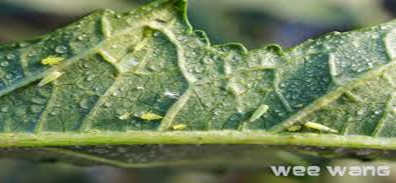Authors: Sharwan Lal Jat**, Swaroop singh* and Nem Raj Sunda**H.D.Choudhary**
*Professor. Division of Entomology R.A.R.I Durgapura SKNAU, Jobner Rajasthan â€" 303329
**Ph.D. Scholars, Dept. of Entomology SKNAU, Jobner Rajasthan â€" 303329
**Ph.D. Scholars, Dept. of Horticulture SKNAU, Jobner Rajasthan - 303329
Email: sharwanento@gmail.com
Okra (Abelmoschus esculentus),Moench also known as lady’s finger or bhendi, belongs tofamily Malvaceae and is an important vegetable crop grown throughout the year. Besides India, It is grown in many tropical and subtropical parts of the world. Tender fruits are used as vegetables or in culinary preparations as sliced and dried pieces. It is also used for thickening gravies and soups, because of its high mucilage content. Matured fruits and stems containing crude fibre are used in paper industry. It has good nutritional value, particularly the high content of vitamin A, potassium, calcium, iron and other minerals like magnesium, sodium and phosphorus, vitamins B and C, fats and carbohydrates. India grows okra on about 5.36 lakh hectares with an annual production of 57.69 lakh tonns and productivity of 13.15 t/ha. The productivity of our country is low compared to other countries due to yield losses caused by insect pests, diseases and nematodes. The crop is attacked by more than 72 insect pests and infests the crop from seedling to harvest stage. The shoot and fruit borer ( Earias vittella), fruit borer(Helicoverpa armigera), leaf roller (Sylepta derogata), leafhopper ( Amrasca biguttula biguttula), whitefly (Bemisia tabaci), aphid (Aphis gossypii), solenopsis mealy bug (Phenacoccus solenopsis), dusky cotton bug (Oxycarenus hyalinipennis), red cotton bug (Dysdercus koenigii) and red spider mite ( Tetranychus urticae) some of important pests which cause damage in okra crop.
1. Shoot and fruit borer (Earias vittella):

Identification: The E. vittella moths measure about 2.5 cm across the wings and have a narrow light longitudinal green band in the middle of forewing. The full grown dull-green caterpillars are 2 cm long having tiny stout bristles and a series of longitudinal black spots on the body.
Damage: The incidence of fruit borers usually occurs during humid conditions after the rainfall. The adult female lays eggs individually on leaves, floral buds and on tender fruits. Small brown caterpillars bore into the top tender shoots and tunnel downwards the main axis which wither, droop down and growing points are killed and later on they bore into the fruits and feed within. Affected fruits become unfit for consumption.
2. Leafhopper (Amrasca biguttula biguttula):

Identification: Adults are small having wedge shaped body measuring about 3 mm long and greenish yellow in colour having a black spot on each forewing and a black spot on the vertex.
Damage: This pest attacks the crop at its early stage of growth. Small, greenish leaf hoppers; nymphs and adults are found on the under side of the leaves. The adults and the nymphs suck the cell sap from the leaves. As a result the leaves curl upwards along the margins and have a burnt look which extend over the entire leaf area. The affected plants show a stunted growth.
3. Whitefly (Bemisia tabaci):

Identification: Adults are winged, they are 1.0-1.5 mm long and their yellowish bodies are slightly dusted with white waxy powder. They have two pairs of pure white wings and have prominent long hind wings.
Damage: The milky white minute whiteflies and nymphs suck the cell sap from the leaves. The affected leaves curl and dry. The affected plants show a stunted growth. Whiteflies are also responsible for transmitting yellow vein mosaic virus (YVMV). Inter woven network of yellow veins encompassing with islands of green tissues on leaves. Later, entire leaves turn yellow. This disease, spread by whitefly, is economically most important disease.
Integrated pest management practices
- Sowing of YVMV resistant cultivars viz. parbhani kranti, makhmali, tulsi, Anupama-1, Varsha Uphar, Hisar Unnat, Arka anamika, Hisar Naveen and Sun-40 etc. especially during kharif season of the crop.
- Seed treatment with imidacloprid 70 WS or thiomethoxam 30FS @ 5gm/ kg of seed.
- Grow maize/sorghum on borders as a barrier to prevent the entry of shoot & fruit borer adults.
- Set up yellow sticky and delta traps for whiteflies.
- Erection of bird perches @10/acre in the field for facilitating bird predation.
- Give two to three sprays of NSKE @ 5% alternating with sprays of pesticides, if needed, against leafhopper, whitefly and mites etc.
- Install pheromone traps @ 5/ acre for monitoring of Earias vittella moth emergence. Replace the lures after every 30-40 days interval.
- Release egg parasitoid Trichogramma chilonis @1-1.5 lakh/ ha starting from 30-35 days after sowing, 4-5 times at weekly interval for shoot & fruit borer.
- Shoot & fruit borer, Earias vittella if crosses ETL (5 % infestation), spray cypermethrin 25 EC @ 200 g a.i/ha or spinosad 45SC @ 0.3 ml/lit or emamectin benzoate 25WG @ 0.4 gm/lit is effective against.
- Rogue out the YVMV affected plants, if any, from time to time.
- Periodically remove and destroy the borer affected shoots and fruits.
- Need based application of chemical pesticides viz. imidacloprid 17.8SL @ 150 ml/ha, cypermethrin 25EC @ 200 g a.i/ha (0.005%), quinalphos 25EC @ 0.05% or propargite 57 EC @ 0.1 % for control of leafhoppers, whiteflies, borers and mites.
- Removal and destruction of alternate weed hosts near the surrounding field.
References:
Anonymous (2015) NHB, Database, 2015
Dhaliwal,G.S. and Arora, R. (2001) Integrated pest management books Kalyani Publishers New Delhi ISBN 978-81-272-3192-4.
Atwal,A.S. and Dhaliwal, G.S.(1976) Agricultural pests of south Asia and their management books Kalyani Publishers New Delhi ISBN 978-93-272-5072-5.
About Author / Additional Info: